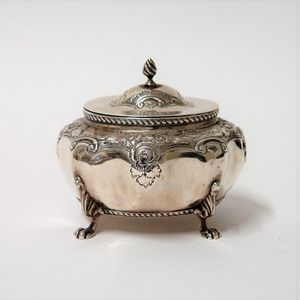Victorian Silver Tea Caddy with Floral Embossing
You must be a subscriber, and be logged in to view price and dealer details.
Subscribe Now to view actual auction price for this item
When you subscribe, you have the option of setting the currency in which to display prices to $Au, $US, $NZ or Stg.
- Oviform /ovoid - The outline loosely resembling the shape of an egg.
- Embossed / Repousse - Embossing, also known as repousse, is the technique of decorating metal with raised designs, by pressing or beating out the design from the reverse side of the object.It is the opposite of chasing, where the decoration is applied from the front. An embossed or repoussed object may have chasing applied to finish off the design.
- Finial - An architectural decoration, found on the upper parts of of an object. On furniture they are usually found on pediments, canopies and shelf supports. On smaller ceramic or silver items, such as spoons, they may decorate the top of the item itself, or the lid or cover where they provide a useful handle for removal.
Finials have a variety of shapes and forms. They may be urn-shaped, baluster shaped round or spiral, but usually taper into an upper point. Many real life shapes may also be used as finials, such as pineapples, berries, pinecones, buds, lotus and acorns. Sometimes animals such as a lion are depicted, or fish and dolphins. - Victorian Period - The Victorian period of furniture and decorative arts design covers the reign of Queen Victoria from 1837 to 1901. There was not one dominant style of furniture in the Victorian period. Designers used and modified many historical styles such as Gothic, Tudor, Elizabethan, English Rococo, Neoclassical and others, although use of some styles, such as English Rococo and Gothic tended to dominate the furniture manufacture of the period.
The Victorian period was preceded by the Regency and William IV periods, and followed by the Edwardian period, named for Edward VII (1841 ? 1910) who was King of the United Kingdom and the British Dominions and Emperor of India for the brief period from 1901 until his death in 1910. - Wrythen - A spirally twisted ornamentation most commonly found on antique glass, silver, ceramics and furniture.
This item has been included into following indexes:
- tea caddies, material - silver and silver plate 243
- tea caddies, period or age
Visually similar items

George III sterling silver sauce tureen, hallmarked London 1815 (W.E), 19 cm high, 15 cm wide with Victorian hallmarked sterling silver liner, 1209 grams

A George IV sterling silver soup tureen and cover, Richard Sibley, London 1822 the tureen of oval form with a gadrooned rim and elaborate acanthus and shell motifs to the handles, raised on four paw feet, the domed cover with applied chasing, gadrooned and

Maling Ware ceramic basket 'Peony Rose' pattern, 25 cm wide approx

A Western New Guinea Highlands stone axe, with a tuft of opossum fur at end on counterweight, some minor chips to stone, 40.5 cm long
